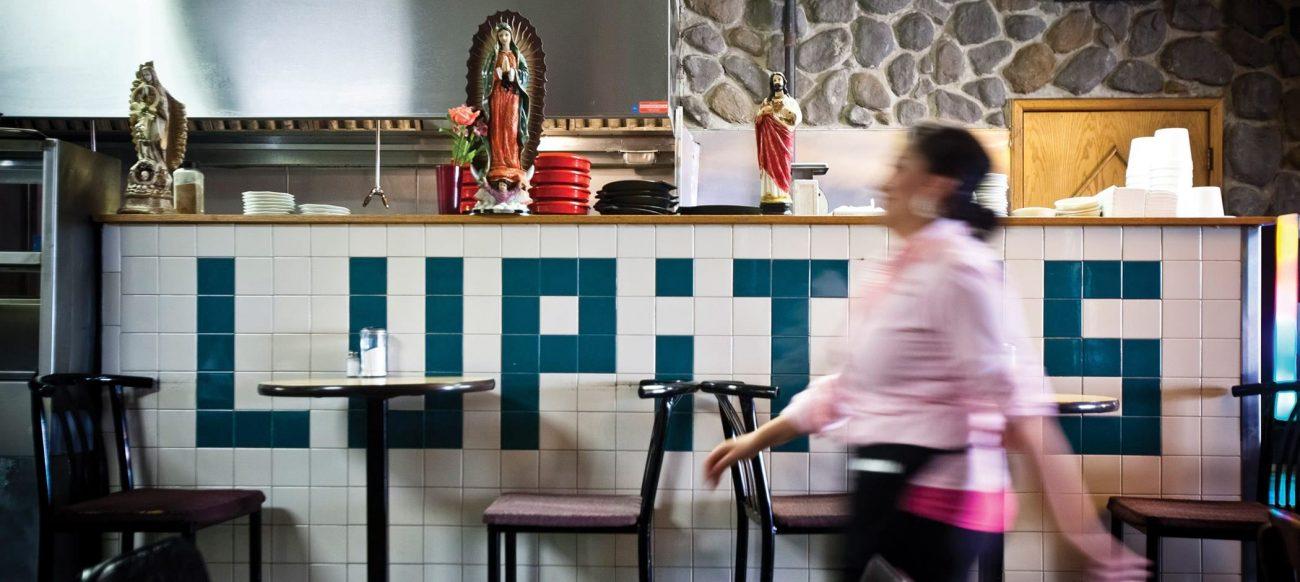
Southwest Detroit: Preserving and Making History
Even though its exact borders may be a subject of debate, one thing is certain when it comes to Southwest Detroit: you need to visit.
The neighborhood, known for its rich culture and community, is undergoing constant change to preserve its history, while continuing its narrative.

People of Southwest Detroit
For many decades now, Southwest Detroit has been one of the main destinations for immigrants seeking jobs and lifestyles that would help them provide for their families. Not only does it still have a reputation for having a diverse community, but it is also known for being an inclusive and welcoming one, so long as current residents’ cultures are respected.
“The community is very collaborative,” President of Southwest Detroit Business Association (SDBA) Robert Dewaelsche said. “The residents and businesses come together to make it a great place to live, work and enjoy. It is no surprise that people are interested in finding more about the area.”
Dewaelsche described Southwest Detroit as a “dense” part of the city since, unlike other parts of Detroit, it has not lost its housing or commercial storefronts. He said a main goal of the community is to maintain this environment and keep products and services within walking or biking distance.
Staples in the Community: Southwest Detroit Businesses
Danto Furniture Detroit is a long-standing Southwest Detroit business, which opened its doors in 1940. It’s a family-owned business that is now on its fourth generation, beginning with Julius Danto, an immigrant from Lithuania, and still continuing now with his great granddaughter, Ashley Silverman.
“My dad remembers being nine-years-old and helping his father move into the new building,” Irwin Danto, grandson of Julius, said about his father, Charles. “At the time, Southwest Detroit was the hub of the automobile industry, and there was no open land in the area. Buildings and people were everywhere.”
Irwin said that there were then 11 other furniture stores in Southwest Detroit, but over time, that number greatly decreased.
“No one walked into the business for days, even weeks at times,” Irwin explained. “A lot of hard work was put in, as well as a lot of personal dedication from my father and grandfather, who were determined through good times and bad times.”
Danto Furniture, like many other “legacy” businesses (as SDBA labels them), has had to make a number of changes as the local population and clientele have shifted over time.
“Half our staff right now speaks Spanish, and we also have a couple people who speak fluent Arabic, too,” Irwin said. “Starting with the Polish, the store has always been supported by the local immigrant population.”
In fact, according to the store’s website, Danto Furniture has been “one of the first stops for new immigrants coming to America” as “newcomers want to make their new country and new house feel like home.”
Another established and popular Southwest business is Honey Bee Market, which has been family-owned and operated for over 60 years. Honey Bee sells fresh fruits, vegetables, meat, seafood, delicatessen goods and canned and frozen products in addition to a large selection of Central American ingredients to both their loyal Hispanic customer base, as well as, what they call (and we at Visit Detroit concur with), the “burgeoning” Southwest community.
“Wake up, and smell the chorizo.” is the store’s slogan, so it should not come as a surprise that it is also a go-to spot for its house-made chorizo, which happens to be a secret family recipe.
If you’re not in the mood to shop and cook, another neighborhood staple is Armando’s Mexican Restaurant, located in the heart of Mexicantown. Established in 1967 but taken over by the Hernandez family in 1986, it has gained an impressive amount of diners who return, again and again, craving the restaurant’s signature dishes and warm atmosphere.
Over the last decade, SDBA has expanded its scope of its community development efforts to encompass the flourishing arts and culture community in Southwest Detroit.
One step towards this is through The Center of Music & Performing Arts Southwest, which started in 2007 and provides year-round, youth-focused arts, recreation and educational opportunities, including lessons in various genres of dance, instrumental music and art with a focus on the rich Latino heritage of Southwest Detroit.
The Atrium Project Space is another community effort which showcases inspiring work that reflects the cultures of Southwest Detroit while simultaneously supporting local artists.
Just recently it has been announced that an exhibit about the historical growth and development of Southwest Detroit will be making its debut in mid-October at Detroit Historical Museum’s Community Gallery.
“It will include everything about the automotive history, cultural diversity, changes in demographics from one generation to the next, the small business community, arts and culture, contributions of non-profit and social agencies and more,” Dewaelsche said. “It will also include current and future trends in Southwest Detroit.”
Mural photo courtesy of Southwest Detroit Business Association. El Asador guacamole photo by Bill Bowen.

Changes and Growth in Southwest
Southwest Detroit is currently undergoing several intentional changes that should yield more growth for the neighborhood.
The Hubbard-Vernor Project is a $12 million mixed-use Detroit development that is expected to be completed and occupied by 2021. The plans are set to include 53 housing units on top of retail and community space between 4000 and 4060 West Vernor Highway. On-site parking will be available for tenants.
Another recent change to this neighborhood is the 17.2-mile Southwest Detroit Greenlink– the longest bike route in Detroit! It allows visitors access to the Latino and Middle Eastern communities in the area as well as important historical sites, such as Southwest Detroit’s auto and labor heritage landmarks.
According to SDBA, the Greenlink “starts on the north side of Patton Park as a 1-mile, off-road path, linking north into Dearborn’s Lapeer Park and its circular path. The bike lanes pick up on West Vernor at the Dearborn border and head east through the neighborhoods of Springwells Village, Vernor/Livernois, Vernor/Junction, Hubbard Farms and Mexicantown. Moving north, the bike lanes take bikers to the Corktown and Core City neighborhoods, linking to the Woodbridge neighborhood and Midtown’s cultural attractions and restaurants.”
Food still remains a staple of Southwest Detroit. Favorites in Mexicantown include Mexican Village and Xochimilco Restaurant, while El Asador and Taqueria El Rey will satisfy your cravings further into Southwest.
New restaurants and bars have recently opened up in Southwest Detroit, including Mutiny Bar, which Food Network recently named as one of the best tiki bars in America, as well as Peso Bar, a new Mexican eatery near Honey Bee Market that serves over 20 different types of margaritas.
“My partners and I are originally from Southwest Detroit, lived here and went to school here,” operating partner of Peso Bar Eddie Vargas said. “We wanted to stay in the community and support the community.”
Peso’s team is working to bring a different way to eat Mexican, putting a “twist” on the Mexican food people are already used to.
“The food is our grandmothers’ recipes but incorporated differently,” Vargas explained. “Customers get a choice of their food being served in a torta, in a burrito or plated.”
Every year, Southwest Detroit hosts many events, particularly the week of Cinco de Mayo; in fact, this year there were five days dedicated to the holiday. There was a celebration of “Dulce,” an effort to shine a spotlight on businesses that sell sweets in Southwest Detroit; a Taco Tour & Tequila Crawl, which consisted of 15 authentic Mexican restaurants and taquerias; a day dedicated to shopping in Southwest Detroit; a fiesta; and even a parade.
Another annual event in the neighborhood is the Run of the Dead, a 5K and 10K run that, connects the observation of those who have passed away with an interactive and health-conscious event.
For more information about upcoming events in Southwest Detroit, visit Southwest Detroit Business Association’s website or Visit Detroit’s event page.
Photos by Bill Bowen.
Story by Danielle Alexander.
Discover more places to visit in Detroit.

Favorite Southwest Detroit Restaurants
Southwest Detroit is loaded with any kind of restaurant you can imagine. But here are a few local favorites.
El Asador: Not your traditional Tex-Mex–instead, you should come here for a quality steak, seafood, or elevated twists on traditional Mexican favorites. We recommend the ribeye con rajas, which is topped with a poblano cream sauce. And you must order the table-side guacamole. El Asador doesn’t serve alcohol, but you can bring your own.
Taqueria El Rey: A favorite among locals and suburbanites alike, Taqueria El Rey has the best grilled chicken in Detroit – you can even watch them grilling it outside as you walk into the tiny eatery. Aside from chicken, order the California-style Big Burrito and stuff it with steak.
El Barzon/La Noria: Fine dining restaurant El Barzon, and it’s more affordable sister restaurant La Noria, combine both Mexican and Italian cuisine to make for a one of a kind menu.
Taqueria Lupita: Located in the Mexicantown section of Southwest Detroit, this establishment offers Mexican favorites like authentic tacos and caldo de res.
Pupuseria Y Restaurante Salvadoreño: The best stop in the area for Salvadorian cuisine. Oorder pupusas, which are thick tortillas filled with beans, meat and cheese.
You May Also Like
Southwest Detroit is a colorful and constantly evolving neighborhood known for its street art, rich…
Even though its exact borders may be a subject of debate, one thing is certain…





